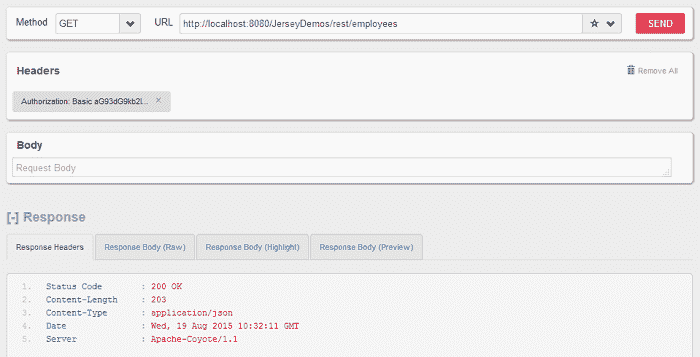Jersey REST API 安全示例
在此 Jersey rest 安全示例中,我们将学习通过基本认证保护 Jersey REST API 的安全。 这将强制每个用户提供用户名/密码以认证到门户。 另外,用户还必须具有一定级别的角色。 我从为 RESTEasy API 安全性创建的另一个示例扩展了此示例,并使用ContainerRequestFilter实现在用户登陆实际的 REST API 之前验证其访问权限。
Table of Contents
1\. Create request authentication filter
2\. Register AuthenticationFilter with ResourceConfig
3\. Secure REST APIs
4\. Test Jersey AuthenticationFilter
1. 创建请求认证过滤器
我们知道 JAX-RS 2.0 具有用于处理请求前和请求的过滤器,因此我们将使用ContainerRequestFilter接口。 在此过滤器中,我们将获取请求尝试访问的方法的详细信息。
我们将找出该方法上所有与安全性相关的配置,并在此过滤器中验证所有内容,例如,注解,例如@PermitAll,@DenyAll或@RolesAllowed。
根据方法上的注解,我们将决定是通过还是阻止请求。
package com.howtodoinjava.jersey.provider;
import java.lang.reflect.Method;
import java.util.Arrays;
import java.util.HashSet;
import java.util.List;
import java.util.Set;
import java.util.StringTokenizer;
import javax.annotation.security.DenyAll;
import javax.annotation.security.PermitAll;
import javax.annotation.security.RolesAllowed;
import javax.ws.rs.container.ContainerRequestContext;
import javax.ws.rs.container.ResourceInfo;
import javax.ws.rs.core.Context;
import javax.ws.rs.core.MultivaluedMap;
import javax.ws.rs.core.Response;
import javax.ws.rs.ext.Provider;
import org.glassfish.jersey.internal.util.Base64;
/**
* This filter verify the access permissions for a user
* based on username and passowrd provided in request
* */
@Provider
public class AuthenticationFilter implements javax.ws.rs.container.ContainerRequestFilter
{
@Context
private ResourceInfo resourceInfo;
private static final String AUTHORIZATION_PROPERTY = "Authorization";
private static final String AUTHENTICATION_SCHEME = "Basic";
@Override
public void filter(ContainerRequestContext requestContext)
{
Method method = resourceInfo.getResourceMethod();
//Access allowed for all
if( ! method.isAnnotationPresent(PermitAll.class))
{
//Access denied for all
if(method.isAnnotationPresent(DenyAll.class))
{
requestContext.abortWith(Response.status(Response.Status.FORBIDDEN)
.entity("Access blocked for all users !!").build(););
return;
}
//Get request headers
final MultivaluedMap<String, String> headers = requestContext.getHeaders();
//Fetch authorization header
final List<String> authorization = headers.get(AUTHORIZATION_PROPERTY);
//If no authorization information present; block access
if(authorization == null || authorization.isEmpty())
{
requestContext.abortWith(Response.status(Response.Status.UNAUTHORIZED)
.entity("You cannot access this resource").build());
return;
}
//Get encoded username and password
final String encodedUserPassword = authorization.get(0).replaceFirst(AUTHENTICATION_SCHEME + " ", "");
//Decode username and password
String usernameAndPassword = new String(Base64.decode(encodedUserPassword.getBytes()));;
//Split username and password tokens
final StringTokenizer tokenizer = new StringTokenizer(usernameAndPassword, ":");
final String username = tokenizer.nextToken();
final String password = tokenizer.nextToken();
//Verifying Username and password
System.out.println(username);
System.out.println(password);
//Verify user access
if(method.isAnnotationPresent(RolesAllowed.class))
{
RolesAllowed rolesAnnotation = method.getAnnotation(RolesAllowed.class);
Set<String> rolesSet = new HashSet<String>(Arrays.asList(rolesAnnotation.value()));
//Is user valid?
if( ! isUserAllowed(username, password, rolesSet))
{
requestContext.abortWith(Response.status(Response.Status.UNAUTHORIZED)
.entity("You cannot access this resource").build(););
return;
}
}
}
}
private boolean isUserAllowed(final String username, final String password, final Set<String> rolesSet)
{
boolean isAllowed = false;
//Step 1\. Fetch password from database and match with password in argument
//If both match then get the defined role for user from database and continue; else return isAllowed [false]
//Access the database and do this part yourself
//String userRole = userMgr.getUserRole(username);
if(username.equals("howtodoinjava") && password.equals("password"))
{
String userRole = "ADMIN";
//Step 2\. Verify user role
if(rolesSet.contains(userRole))
{
isAllowed = true;
}
}
return isAllowed;
}
}
2. 向ResourceConfig注册AuthenticationFilter
现在,您需要在ResourceConfig实例上方注册过滤器。 因此,创建一个如下所示的实例:
package com.howtodoinjava.jersey;
import org.glassfish.jersey.filter.LoggingFilter;
import org.glassfish.jersey.server.ResourceConfig;
import com.howtodoinjava.jersey.provider.AuthenticationFilter;
import com.howtodoinjava.jersey.provider.GsonMessageBodyHandler;
public class CustomApplication extends ResourceConfig
{
public CustomApplication()
{
packages("com.howtodoinjava.jersey");
register(LoggingFilter.class);
register(GsonMessageBodyHandler.class);
//Register Auth Filter here
register(AuthenticationFilter.class);
}
}
并将此资源配置添加到web.xml文件中。
<!DOCTYPE web-app PUBLIC
"-//Sun Microsystems, Inc.//DTD Web Application 2.3//EN"
"http://java.sun.com/dtd/web-app_2_3.dtd" >
<web-app>
<display-name>Archetype Created Web Application</display-name>
<servlet>
<servlet-name>jersey-serlvet</servlet-name>
<servlet-class>org.glassfish.jersey.servlet.ServletContainer</servlet-class>
<init-param>
<param-name>javax.ws.rs.Application</param-name>
<param-value>com.howtodoinjava.jersey.CustomApplication</param-value>
</init-param>
<load-on-startup>1</load-on-startup>
</servlet>
<servlet-mapping>
<servlet-name>jersey-serlvet</servlet-name>
<url-pattern>/rest/*</url-pattern>
</servlet-mapping>
</web-app>
3. 安全的 REST API
现在是时候保护 REST API 了。 如下使用标准的 JAX-RS 注解。
@Path("/employees")
public class JerseyService
{
@RolesAllowed("ADMIN")
@GET
@Produces(MediaType.APPLICATION_JSON)
@Consumes(MediaType.APPLICATION_JSON)
public Employees getAllEmployees()
{
Employees list = new Employees();
list.setEmployeeList(new ArrayList<Employee>());
list.getEmployeeList().add(new Employee(1, "Lokesh Gupta"));
list.getEmployeeList().add(new Employee(2, "Alex Kolenchiskey"));
list.getEmployeeList().add(new Employee(3, "David Kameron"));
return list;
}
}
4. 测试 Jersey AuthenticationFilter
让我们测试认证设置是否有效。
点击 URL:http://localhost:8080/JerseyDemos/rest/employees

Jersey 认证失败的请求
在基本认证参数中传递用户名和密码:howtodoinjava/password

Jersey 认证成功的请求
单击下面的链接下载 jersey rest api 认证示例应用的源代码。
学习愉快!